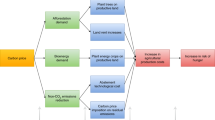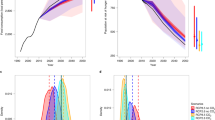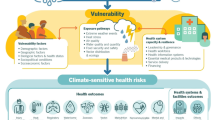Abstract
Holding the global increase in temperature caused by climate change well below 2 °C above pre-industrial levels, the goal affirmed by the Paris Agreement, is a major societal challenge. Meanwhile, food security is a high-priority area in the UN Sustainable Development Goals, which could potentially be adversely affected by stringent climate mitigation. Here we show the potential negative trade-offs between food security and climate mitigation using a multi-model comparison exercise. We find that carelessly designed climate mitigation policies could increase the number of people at risk of hunger by 160 million in 2050. Avoiding these adverse side effects would entail a cost of about 0.18% of global gross domestic product in 2050. It should be noted that direct impacts of climate change on yields were not assessed and that the direct benefits from mitigation in terms of avoided yield losses could be substantial, further reducing the above cost. Although results vary across models and model implementations, the qualitative implications are robust and call for careful design of climate mitigation policies taking into account agriculture and land prices.
This is a preview of subscription content, access via your institution
Access options
Access Nature and 54 other Nature Portfolio journals
Get Nature+, our best-value online-access subscription
$29.99 / 30 days
cancel any time
Subscribe to this journal
Receive 12 digital issues and online access to articles
$119.00 per year
only $9.92 per issue
Buy this article
- Purchase on Springer Link
- Instant access to full article PDF
Prices may be subject to local taxes which are calculated during checkout





Similar content being viewed by others
Data availability
Scenario data are accessible online via the CD-LINKS Scenario Database at https://db1.ene.iiasa.ac.at/CDLINKSDB. Data derived from the original scenario database, which are shown as figures but are not in the above database, are available upon reasonable request from the corresponding author.
References
FAOSTAT 2016 (FAO, accessed 9 February 2016); https://faostat.fao.org
The State of Food Insecurity in the World 2015—Meeting the 2015 International Hunger Targets: Taking Stock of Uneven Progress (FAO: Rome, 2015).
Parry, M. L., Rosenzweig, C., Iglesias, A., Livermore, M. & Fischer, G. Effects of climate change on global food production under SRES emissions and socio-economic scenarios. Glob. Environ. Change 14, 53–67 (2004).
Nelson, G. C. et al. Food Security, Farming, and Climate Change to 2050, Scenarios, Results, Policy Options (IFPRI, 2010).
Rosenzweig, C. & Parry, M. L. Potential impact of climate change on world food supply. Nature 367, 133–138 (1994).
Hasegawa, T. et al. Climate change impact and adaptation assessment on food consumption utilizing a new scenario framework. Environ. Sci. Technol. 48, 438–445 (2014).
Hasegawa, T. et al. Consequence of climate mitigation on the risk of hunger. Environ. Sci. Technol. 49, 7245–7253 (2015).
Obersteiner, M. et al. Assessing the land resource–food price nexus of the sustainable development goals. Sci. Adv. 2, e1501499 (2016).
Lotze-Campen, H. et al. Impacts of increased bioenergy demand on global food markets: an AgMIP economic model intercomparison. Agric. Econ. 45, 103–116 (2014).
Stevanović, M. et al. Mitigation strategies for greenhouse gas emissions from agriculture and land-use change: consequences for food prices. Environ. Sci. Technol. 51, 365–374 (2017).
Springmann, M. et al. Mitigation potential and global health impacts from emissions pricing of food commodities. Nat. Clim. Change 7, 69–74 (2017).
Havlík, P. et al. Climate change mitigation through livestock system transitions. Proc. Natl Acad. Sci. USA 111, 3709–3714 (2014).
Stefan, F. et al. Reducing greenhouse gas emissions in agriculture without compromising food security? Environ. Res. Lett. 12, 105004 (2017).
Fujimori, S. et al. Inclusive climate change mitigation and food security policy under 1.5 °C climate goal. Environ. Res. Lett. 13, 074033 (2018).
Adoption of the Paris Agreement FCCC/CP/2015/L.9/Rev.1 (UNFCCC, 2015).
Fujimori, S. et al. Implication of Paris Agreement in the context of long-term climate mitigation goals. SpringerPlus 5, 1–11 (2016).
Popp, A. et al. Land-use protection for climate change mitigation. Nat. Clim. Change 4, 1095–1098 (2014).
Rose, S. K. et al. Bioenergy in energy transformation and climate management. Climatic Change 123, 477–493 (2014).
Fuss, S. et al. Betting on negative emissions. Nat. Clim. Change 4, 850–853 (2014).
Reilly, J. et al. Using land to mitigate climate change: hitting the target, recognizing the trade-offs. Environ. Sci. Technol. 46, 5672–5679 (2012).
Kriegler, E. et al. Making or breaking climate targets: the AMPERE study on staged accession scenarios for climate policy. Technol. Forecast. Soc. Change 90, 24–44 (2015).
Fujimori, S. et al. SSP3: AIM implementation of Shared Socioeconomic Pathways. Glob. Environ. Change 42, 268–283 (2017).
van Vuuren, D. P. et al. Energy, land-use and greenhouse gas emissions trajectories under a green growth paradigm. Glob. Environ. Change 42, 237–250 (2017).
Fricko, O. et al. The marker quantification of the Shared Socioeconomic Pathway 2: a middle-of-the-road scenario for the 21st century. Glob. Environ. Change 42, 251–267 (2017).
Kriegler, E. et al. Fossil-fueled development (SSP5): an energy and resource intensive scenario for the 21st century. Glob. Environ. Change 42, 297–315 (2017).
Joint Research Centre POLES: Global Energy Model (European Union, 2016).
Emmerling J. et al. The WITCH 2016 Model—Documentation and Implementation of the Shared Socioeconomic Pathways (Elsevier, 2016).
Gernaat, D. E. H. J. et al. Understanding the contribution of non-carbon dioxide gases in deep mitigation scenarios. Glob. Environ. Change 33, 142–153 (2015).
Hasegawa, T., Fujimori, S., Takahashi, K. & Masui, T. Scenarios for the risk of hunger in the twenty-first century using Shared Socioeconomic Pathways. Environ. Res. Lett. 10, 014010 (2015).
Hasegawa, T., Fujimori, S., Takahashi, K., Yokohata, T. & Masui, T. Economic implications of climate change impacts on human health through undernourishment. Climatic Change 136, 1–14 (2016).
Hasegawa, T. et al. Risk of increased food insecurity under stringent global climate change mitigation policy. Nat. Clim. Change 8, 699–703 (2018).
Schmidhuber, J. & Tubiello, F. N. Global food security under climate change. Proc. Natl Acad. Sci. USA 104, 19703–19708 (2007).
Rogelj, J. et al. Special Report: Global Warming of 1.5 ºC (eds Flato, G. et al.) Ch. 2 (IPCC, Cambridge Univ. Press, 2018).
McCollum, D. L., Krey, V. & Riahi, K. An integrated approach to energy sustainability. Nat. Clim. Change 1, 428–429 (2011).
Jewell, J. et al. Comparison and interactions between the long-term pursuit of energy independence and climate policies. Nat. Energy 1, 16073 (2016).
van Vuuren, D. P. et al. Exploring the ancillary benefits of the Kyoto protocol for air pollution in Europe. Energy Policy 34, 444–460 (2006).
McCollum, D. L. et al. Climate policies can help resolve energy security and air pollution challenges. Climatic Change 119, 479–494 (2013).
Cameron, C. et al. Policy trade-offs between climate mitigation and clean cook-stove access in South Asia. Nat. Energy 1, e15010 (2016).
Net ODA (OECD, 2017); https://data.oecd.org/oda/net-oda.htm
Hertel, T. W., Burke, M. B. & Lobell, D. B. The poverty implications of climate-induced crop yield changes by 2030. Glob. Environ. Change 20, 577–585 (2010).
Zekarias, H., Thomas, H. & Alla, G. Climate change mitigation policies and poverty in developing countries. Environ. Res. Lett. 8, 035009 (2013).
van Vuuren, D. P. et al. Alternative pathways to the 1.5 °C target reduce the need for negative emission technologies. Nat. Clim. Change 8, 391–397 (2018).
Roy, J. et al. Special Report: Global Warming of 1.5 ºC (eds Krakovska, S. et al.) Ch. 5 (IPCC, Cambridge Univ. Press, 2018).
Grubler, A. et al. A low energy demand scenario for meeting the 1.5 °C target and sustainable development goals without negative emission technologies. Nat. Energy 3, 515–527 (2018).
Wise, M. et al. Implications of limiting CO2 concentrations for land use and energy. Science 324, 1183–1186 (2009).
Frank, S. et al. Agricultural non-CO2 emission reduction potential in the context of the 1.5 °C target. Nat. Clim. Change 9, 66–72 (2019).
von Lampe, M. et al. Why do global long-term scenarios for agriculture differ? An overview of the AgMIP global economic model intercomparison. Agric. Econ. 45, 3–20 (2014).
Nelson, G. C. et al. Climate change effects on agriculture: economic responses to biophysical shocks. Proc. Natl Acad. Sci. USA 111, 3274–3279 (2014).
Keith, W. et al. Climate change impacts on agriculture in 2050 under a range of plausible socioeconomic and emissions scenarios. Environ. Res. Lett. 10, 085010 (2015).
Valin, H. et al. The future of food demand: understanding differences in global economic models. Agric. Econ. 45, 51–67 (2014).
Luderer, G. et al. Residual fossil CO2 emissions in 1.5–2 °C pathways. Nat. Clim. Change 8, 626–633 (2018).
Hall, A. Projecting regional change. Science 346, 1461–1462 (2014).
Krey, V. et al. Looking under the hood: A comparison of techno-economic assumptions across national and global integrated assessment models. Energy 172, 1254–1267 (2019).
Fujimori S., Masui T. & Matsuoka Y. AIM/CGE [Basic] Manual (National Institute Environmental Studies, 2012).
Fujimori, S., Hasegawa, T., Masui, T. & Takahashi, K. Land use representation in a global CGE model for long-term simulation: CET vs. logit functions. Food Sec. 6, 685–699 (2014).
Stehfest E. et al. (eds) Integrated Assessment of Global Environmental Change with IMAGE 3.0: Model Description and Policy Applications (Netherlands Environmental Assessment Agency, 2014).
Woltjer, G. B. & Kuiper, M. H. The MAGNET Model: Module Description. (LEI Wageningen UR, 2014).
Lucas, P. L., van Vuuren, D. P., Olivier, J. G. J. & den Elzen, M. G. J. Long-term reduction potential of non-CO2 greenhouse gases. Environ. Sci. Policy 10, 85–103 (2007).
Messner, S. & Schrattenholzer, L. MESSAGE–MACRO: linking an energy supply model with a macroeconomic module and solving it iteratively. Energy 25, 267–282 (2000).
Kindermann, G. E., Obersteiner, M., Rametsteiner, E. & McCallum, I. Predicting the deforestation-trend under different carbon-prices. Carbon Balance Manage. 1, 15 (2006).
Meinshausen, M., Raper, S. C. B. & Wigley, T. M. L. Emulating coupled atmosphere-ocean and carbon cycle models with a simpler model, MAGICC6–part 1: model description and calibration. Atmos. Chem. Phys. 11, 1417–1456 (2011).
Keramidas K. et al. POLES-JRC Model Documentation (European Union, 2017).
Lotze-Campen, H. et al. Global food demand, productivity growth, and the scarcity of land and water resources: a spatially explicit mathematical programming approach. Agric. Econ. 39, 325–338 (2008).
Bonsch, M. et al. Trade-offs between land and water requirements for large-scale bioenergy production. GCB Bioenergy 8, 11–24 (2016).
Dietrich, J. P., Schmitz, C., Lotze-Campen, H., Popp, A. & Müller, C. Forecasting technological change in agriculture—an endogenous implementation in a global land use model. Technol. Forecast. Soc. Change 81, 236–249 (2014).
Bodirsky, B. L. et al. N2O emissions from the global agricultural nitrogen cycle—current state and future scenarios. Biogeosciences 9, 4169–4197 (2012).
Bosetti, V. et al. WITCH—a world induced technical change hybrid model. Energy J. 27, 13–37 (2006).
The State of Food Insecurity in the World 2012: Economic Growth is Necessary But Not Sufficient to Accelerate Reduction of Hunger and Malnutrition (FAO, WFP and IFAD, 2012).
Emission Database for Global Atmospheric Research (EDGAR) release version (EC and JRC, accessed 2012); http://edgar.jrc.ec.europa.eu
FAO Methodology for the Measurement of Food Deprivation: Updating the Minimum Dietary Energy Requirements (FAO, 2008).
Food Security Indicators (FAO, 2013).
Energy and Protein Requirements (FAO, WHO and UNU, 1973).
Shared Socioeconomic Pathways (SSP) Database v.0.9.3 (IIASA, 2012).
Acknowledgements
S.Fujimori, T.H. and K.T. are supported by JSPS KAKENHI Grant Number JP16K18177, JSPS Overseas Research Fellowships and the Environment Research and Technology Development Fund (2-1702) of the Environmental Restoration and Conservation Agency of Japan. J.Després and A.S. are funded by the European Commission. All other authors received funding from the European Union’s Horizon 2020 research and innovation programme under grant agreement no. 642147 (CD-LINKS). The views expressed are purely those of the writer and may not in any circumstances be regarded as stating an official position of the European Commission.
Author information
Authors and Affiliations
Contributions
S.Fujimori, V.K. and K.R. designed the research; S.Fujimori carried out analysis of the modelling results, created figures and wrote the draft of the paper; T.H. and Y.O. carried out hunger estimation tool simulation; S.Fujimori and T.H. provided AIM data; J.Doelman, J.K., H.v.M. and D.v.V. provided IMAGE data; O.F., S.Frank and P.H. provided MESSAGE–GLOBIOM data; J.Després and A.S. provided POLES data; B.L.B., F.H. and A.P. provided REMIND–MAgPIE data; V.B., L.D. and J.E. provided WITCH data; J.C. edited English language; and all authors contributed to the discussion and interpretation of the results.
Corresponding author
Ethics declarations
Competing interests
The authors declare no competing interests.
Additional information
Publisher’s note: Springer Nature remains neutral with regard to jurisdictional claims in published maps and institutional affiliations.
Supplementary Information
Supplementary Information
Supplementary Notes, Supplementary Figs. 1–16, Supplementary Tables 1–3, Supplementary Refs. 1–20
Rights and permissions
About this article
Cite this article
Fujimori, S., Hasegawa, T., Krey, V. et al. A multi-model assessment of food security implications of climate change mitigation. Nat Sustain 2, 386–396 (2019). https://doi.org/10.1038/s41893-019-0286-2
Received:
Accepted:
Published:
Issue Date:
DOI: https://doi.org/10.1038/s41893-019-0286-2
This article is cited by
-
Trade-offs in land-based carbon removal measures under 1.5 °C and 2 °C futures
Nature Communications (2024)
-
Does integrating climate change projection with agriculture policy improve agricultural adaptation and food security? Evidence from Bangladesh
Theoretical and Applied Climatology (2024)
-
Historical Changes and Multi-scenario Prediction of Land Use and Terrestrial Ecosystem Carbon Storage in China
Chinese Geographical Science (2024)
-
Feasibility of mitigation measures for agricultural greenhouse gas emissions in the UK. A systematic review
Agronomy for Sustainable Development (2024)
-
Asymmetric Drying and Wetting Trends in Eastern and Western China
Advances in Atmospheric Sciences (2024)



